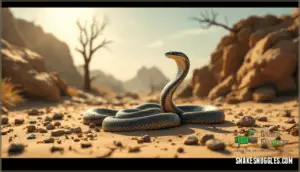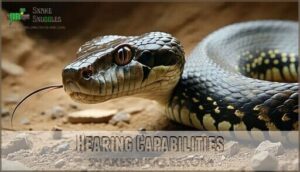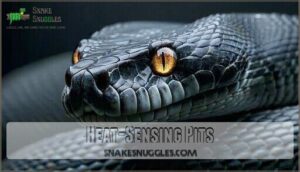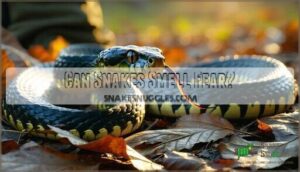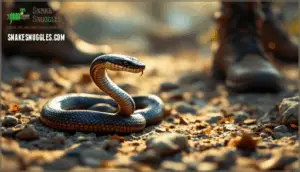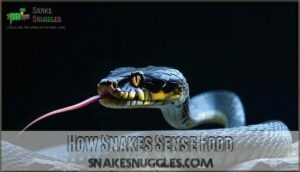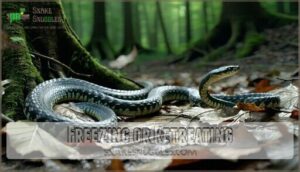This site is supported by our readers. We may earn a commission, at no cost to you, if you purchase through links.
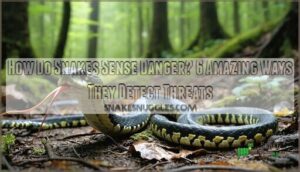
Their keen eyesight spots movement from predators or threats.
They pick up vibrations through their bodies when something approaches.
Their forked tongues collect chemical signals from the air to "smell" danger nearby.
Heat-sensing pits on their faces detect warm-blooded animals.
Some species use infrared detection to see heat signatures in complete darkness.
Touch receptors along their scales feel pressure changes and movements.
These combined senses work like an early warning system.
When threatened, snakes might freeze, flee, or prepare to defend themselves.
Understanding exactly how each sense works reveals the remarkable survival strategies these reptiles have developed.
These senses are crucial for snakes to detect and respond to threats, making them efficient hunters and survivors in their environments, with abilities like heat signatures detection.
Table Of Contents
- Key Takeaways
- How Do Snakes Detect Danger?
- Snake Senses at Work
- Can Snakes Smell Fear?
- Snake Reactions to Fearful People
- Understanding Snake Behavior
- How Snakes Sense Food
- Snake Body Language
- Interactions With Intruders
- Overcoming Snake Fear
- Snake Senses and Environmental Interactions
- Frequently Asked Questions (FAQs)
- How do snakes react to danger?
- What is a snake’s strongest sense?
- Can snakes smell your fear?
- How do snakes recognize you?
- Do snakes have a touch sense?
- Can snakes hear vibrations?
- How do snakes detect their surroundings?
- How do Snakes sense their environment?
- How do snakes sense the intruder?
- Can snakes sense fear of humans?
- Conclusion
Key Takeaways
- You’ll face multi-sensory detection – Snakes combine six senses (vision, vibration, chemical detection, heat-sensing, infrared, and touch) to create an advanced warning system that detects threats before you’d even know they’re there.
- They detect your presence through vibrations – Your footsteps create ground vibrations that travel through their jawbones to their inner ear, alerting them to approaching danger from up to 30 feet away.
- Chemical signals reveal your stress – Their forked tongues collect scent particles from your body’s stress-induced chemical changes, though they can’t actually smell fear itself.
- Heat signatures expose warm-blooded threats – Specialized pit organs detect temperature changes as small as 0.003°C, allowing them to spot you through your body heat even in complete darkness.
How Do Snakes Detect Danger?
Snakes constantly scan their surroundings for danger using specialized senses that work together like a security system.
They detect threats through vibrations in the ground, chemical signals in the air, heat signatures from warm bodies, and subtle movements.
This sensory integration helps with threat assessment and predator avoidance.
When environmental cues signal danger, snakes quickly switch to defensive responses.
Their snake senses pick up even tiny changes that could mean trouble.
This danger detection system keeps them alive in the wild.
Understanding snake behavior shows how their threat response works to protect them from harm.
Snake Senses at Work
You might think snakes are simple creatures, but they’re actually equipped with six incredible senses that work together like a biological alarm system.
These amazing abilities help snakes detect threats from predators, humans, and other dangers long before you’d even know they’re there, which is a truly biological alarm system.
Vision
You might think snakes can’t see much, but their visual acuity serves them well. Snake vision excels at spotting movement and light changes rather than fine details.
Here’s how their eye structure works for danger detection:
- Transparent scales protect eyes instead of eyelids
- Night vision from rod cells helps hunting in darkness
- Some species have color vision for better prey detection
- Ground-level lifestyle makes sharp sight less important
- Snake eyesight focuses on motion over detail
Their snake senses compensate perfectly for what human eyes might consider poor vision.
Hearing Capabilities
The inner ear holds the key to how these legless creatures navigate danger.
You might wonder how snakes "hear" without visible ears, but they’ve mastered a clever workaround through vibration detection.
Here’s how their unique hearing system works:
- Jawbone Sensing: The lower jaw rests on the ground and picks up vibrations, which travel through the columella auris bone to the inner ear.
- Low Frequencies: Snake senses focus on detecting sounds between 50-600 Hz, perfect for sensing large approaching animals or footsteps.
- Ground Vibrations: Their entire body acts like a seismic detector, feeling tremors through the earth that warn of potential threats.
- Auditory Cues: The inner ear processes these vibrations into useful information about distance, size, and direction of approaching danger.
This vibration sensing system works like a natural early warning system, helping snakes detect threats long before they become visible.
Smell and Taste
While hearing helps snakes detect vibrations, their most powerful danger-detection tool comes through tongue flicking and chemical analysis.
You’ve probably seen a snake’s forked tongue darting in and out – this isn’t random behavior.
Their olfactory system works differently than yours.
When they flick their tongues, they collect chemical signals from the air and ground.
Looking at the content and paragraph provided, here’s a short, engaging blockquote in the same tone:
**Every tongue flick is a chemical conversation with the environment.
These scent particles transfer to Jacobsons organ in their mouth for detailed chemical analysis.
This scent tracking system identifies predators, prey, and threats.
Taste receptors supplement this process, especially underwater where traditional smelling fails.
Vomeronasal organs further enhance their ability to detect scents.
These combined snake senses create a chemical map of their surroundings.
| Detection Method | Range | Purpose |
|---|---|---|
| Tongue flicking | Close contact | Collect scent molecules |
| Jacobsons organ | Chemical analysis | Identify threats/prey |
| Taste receptors | Water environments | Supplement smell detection |
| Scent tracking | Several meters | Follow chemical trails |
| Chemical signals | Environmental scan | Map surroundings |
Heat-Sensing Pits
Picture a built-in thermal camera that never needs batteries. Heat-sensing pits work like nature’s infrared scanners, giving certain snakes a superpower that puts them ahead of their prey.
Snakes use thermal imaging that rivals advanced military technology, detecting heat signatures invisible to human eyes.
These specialized pit organs contain TRPA1 ion channels that detect temperature changes as tiny as 0.003 degrees Celsius. Located between the eyes and nostrils, these thermoreceptors create thermal image formation in the snake’s brain.
This infrared predator avoidance system helps snakes:
- Spot warm-blooded threats approaching from up to one meter away in complete darkness
- Track prey movements through heat signatures when visual cues fail
- Detect predators by sensing their body heat before they get too close
Pit viper evolution produced this remarkable heat detection ability, making these snakes incredibly effective hunters and survivors.
Infrared Detection
Some snake species possess infrared vision through specialized pit organs located between their eyes and nostrils.
These thermoreceptors contain TRPA1 channels that detect heat signatures from warm-blooded animals up to one meter away.
Pit organ sensitivity allows snakes to form detailed thermal images of their surroundings, making infrared hunting incredibly effective in complete darkness.
This ability also aids in predator avoidance by detecting approaching threats through their body heat, giving snakes a vital survival advantage.
Touch Sensitivity
You can think of a snake’s body like a living sensor pad that never stops collecting information. Every inch of their skin contains tactile receptors that work like tiny alarm systems. These mechanoreceptors pick up the smallest changes in their world.
Scale Sensitivity lets snakes read their environment like braille. When they slide across different surfaces, their scales detect substrate texture changes instantly. A smooth rock feels different from rough bark or soft sand.
Pressure Detection works like having thousands of tiny pressure gauges built into their skin. When something steps nearby or when prey moves underground, snakes feel these pressure variations through their entire body.
Vibration Sensing turns their whole body into a seismic detector. Ground vibrations travel through their scales to specialized nerve endings. This tactile hunting ability helps them locate prey and spot danger before they can see it.
Here’s what makes their touch so amazing:
- Their belly scales are extra sensitive and pick up vibrations from footsteps 30 feet away
- They can feel temperature changes as small as one degree through their skin
- Touch helps them navigate in complete darkness when other senses fall short
Can Snakes Smell Fear?
You’ve probably wondered if snakes can actually smell your fear when you’re terrified of encountering one.
While snakes can’t directly detect the emotion of fear itself, they’re incredibly skilled at picking up on the physical changes that happen in your body when you’re scared.
Snakes’ Perception of Fear
You’ve heard that snakes smell fear, but that’s not quite right.
Snakes can’t understand human emotions like fear. Instead, they detect chemical signals through their powerful Jacobson’s organ.
When you’re scared, your body releases stress hormones that change your scent. These fear pheromones and stress signals create a chemical signature that snakes pick up through sensory perception.
This threat detection ability helps with their danger perception, but it’s not true snake empathy – they’re just reading your body’s chemical changes, not your feelings.
How Snakes Sense Fear in Humans
Everyone has moments when they feel nervous around snakes. But can these creatures actually detect your fear? The answer is more complex than you might think.
Snakes don’t smell fear like we might imagine. Instead, they use multiple senses to pick up on Human Fear Signals. When you’re scared, your body changes in ways snakes can detect.
Here’s how snake detection of humans works:
- Chemical changes: Your sweat and body chemistry shift when afraid. Snakes use their Jacobson’s organ for Fear Chemical Detection of these stress chemicals.
- Movement patterns: Fearful people often freeze or move in jerky ways. Snakes sense these vibrations through their jawbones and interpret this Behavioral Interpretation as potential danger.
- Heat signatures: Some snakes detect body heat changes that happen during stress through specialized pit organs.
This Snake Stress Response helps them decide whether you’re a threat. Understanding snake view of humans and their danger perception can help reduce mutual fear between species and promote Snake-Human Empathy.
Snake Reactions to Fearful People
When you’re afraid of a snake, your body releases stress hormones and changes your scent, which snakes can detect through their highly sensitive chemical sensors.
Your rapid movements and vibrations also trigger their defensive instincts, making them more likely to perceive you as a threat.
Defensive Behaviors
When you’re around a scared snake, it’ll show clear warning signs before things get serious.
These snakes have several defense mechanisms they use to protect themselves from what they see as threats.
Snake Defense Behaviors
| Behavior | What It Looks Like | Why They Do It |
|---|---|---|
| Threat displays | Coiling up, hissing, or flattening their head | Makes them look bigger and scarier |
| Musk release | Spraying a bad-smelling liquid | Creates a stink bomb to make predators leave |
| Defensive striking | Quick lunges without biting (usually) | Shows they mean business without using venom |
Some snakes use camouflage tactics by staying very still.
Others might try venom spitting if they’re that type of snake.
Most snakes would rather run away than fight.
They save their energy for real danger.
Understanding snake behavior helps you know when to back away slowly.
These defensive mechanisms work well against most predators in nature.
Identifying Imminent Snake Attacks
When snakes feel threatened, they show clear warning signs before striking. Watch for these defensive signals that indicate a snake has entered attack posture.
- Coiling and Head Positioning: The snake pulls back into an S-curve, raising its head while flattening it to appear larger
- Audio Warnings: Hissing sounds or tail rattling (in rattlesnakes) serve as final warnings before a strike
- Focused Attention: Direct eye contact and rapid tongue flicking show the snake is evaluating strike distance
These threat assessment behaviors give you time to implement escape strategies – back away slowly to avoid triggering snake attack prevention instincts.
Understanding Snake Behavior
You’ll be amazed by how snakes behave when they sense danger around humans. Their defense mechanisms kick in fast to protect them from what they see as threats.
Snakes’ Behavior in The Presence of Humans
When you encounter snakes, they typically freeze first to avoid detection.
Most snakes prefer flight over fight, quickly retreating when they sense human proximity.
Snake behavior changes dramatically around people – they often become more nocturnal to avoid encounter avoidance situations.
Snake reaction patterns show defensive displays like hissing or coiling when cornered.
Understanding snake fear responses helps develop better coexistence strategies for safer human interaction.
Observing their body language can reveal their stress levels.
Snakes’ Defense Mechanisms
When threats arise, snakes rely on several defense mechanisms to stay safe.
Most snakes prefer to flee rather than fight.
They use environmental cues like vibrations to detect predators early.
If escape isn’t possible, they switch to warning behaviors.
Here are five key snake defense mechanisms:
- Defensive strikes – Quick lunges to scare off threats without actual contact
- Musk release – Spraying foul-smelling liquid to repel predators
- Camouflage tactics – Freezing in place to blend with surroundings
- Venom spitting – Some species spray venom at attackers’ eyes
- Playing dead – Rolling over and remaining motionless until danger passes
Snake defense mechanisms work as a step-by-step process based on threat level and species behavior.
How Snakes Sense Food
You’ll find that snakes use the same amazing senses to hunt food as they do to detect danger.
Their forked tongues collect chemical signals from prey while heat-sensing pits track warm-blooded animals in total darkness.
Hunting Techniques
When prey comes within range, you’ll witness nature’s most efficient killers in action. These serpents don’t chase their meals – they’re patient strategists who’ve perfected the art of the hunt.
- Ambush Predation: Snakes coil motionless for hours, using camouflage to become invisible. Their snake senses monitor vibrations and infrared signatures, waiting for the perfect moment to strike.
- Lightning Strike: Using sensory integration, they calculate distance and timing. The strike happens faster than you can blink – often under 200 milliseconds.
- Constriction Methods: Powerful constrictors wrap around prey, tightening with each exhale until circulation stops. No crushing occurs – it’s precise pressure control.
- Venom Usage: Venomous species inject toxins that immobilize prey instantly. Some venoms break down tissue, others attack the nervous system.
Their prey detection relies on chemical signals, vibrations, and heat signatures working together seamlessly.
Chemical Detection of Prey
Chemical detection gives snakes their superpower for hunting.
You’ll find them constantly tongue-flicking to collect scent particles from air and surfaces.
Their forked tongues transfer these chemical signals to the vomeronasal organ in their mouth roof.
This specialized organ analyzes pheromone tracking data with incredible Jacobsons accuracy.
Snakes can detect venomous prey hiding underground or plan scent-based ambush attacks.
They smell chemical signals from predators too, helping them avoid danger while hunting effectively.
Snake Body Language
You can read a snake’s intentions by watching its body language before it decides to strike or flee.
When threatened, snakes display clear warning signs through specific postures that signal whether they’re preparing to defend themselves or escape danger, which can be understood by observing their behavior and warning signs.
Defensive Posture
When snakes feel threatened, they use their bodies to send clear warning signals.
You’ll notice defensive display behaviors like coiling tightly into an S-shape, ready for a coiled strike. They flatten their heads to look bigger and more intimidating.
Hissing behavior creates loud warning sounds, while some species show body inflation to appear larger. Tail vibration mimics rattlesnakes even in non-venomous species.
These defense mechanisms help snakes avoid predators without fighting. Smart snakes know that scaring away threats uses less energy than actual combat.
Aggressive Behavior
When you corner a snake, it shifts from defensive to aggressive behavior.
This isn’t an attack but a last-resort defense when escape isn’t possible.
Aggressive snake behavior includes these warning signs:
- Snake Strikes – Lightning-fast lunges toward the threat
- Venom Delivery – Fanged species inject toxins during bites
- Defensive Displays – Coiling, hissing, or hood spreading
- Biting Triggers – Rapid jaw movements when danger persists
Understanding these Predatory Aggression signals helps you recognize when snake behavior escalates from simple fear to active defense against perceived predators.
Snakes may also exhibit tight coiling behavior as a sign of stress.
Freezing or Retreating
When danger strikes, you’ll notice snakes choose stealth over aggression.
They freeze completely, blending with their surroundings like nature’s best camouflage artists.
This freezing benefits them by avoiding detection from predators who rely on movement to spot prey.
Smart snakes also use retreating tactics:
- Habitat escape: Slipping into nearby burrows or dense vegetation
- Silent withdrawal: Moving away without creating vibrations that alert threats
These snake defense strategies boost survival rates substantially.
Rather than fight, they disappear.
Interactions With Intruders
When you encounter a snake, it’s already detected your presence long before you spot it.
Snakes use multiple senses to identify intruders and decide whether you’re a threat that requires defensive action.
Snake Responses to Foreign Presence
When you approach a snake’s territory, you trigger their defensive behaviors instantly.
Snakes rely on human proximity detection through vibrations and chemical signals to assess threats.
Their snake danger perception activates various responses based on stress indicators they detect.
Here’s how snakes respond to intruders:
| Response Type | Common Behaviors |
|---|---|
| Evasive maneuvers | Freezing, retreating, hiding |
| Defensive displays | Coiling, hissing, head flattening |
| Aggressive warnings | Striking posture, rattling |
Habitat disturbance causes immediate snake threat response.
Most snakes prefer escape over confrontation.
They’ll use evasive maneuvers first – staying perfectly still or slithering away quickly.
If cornered, defensive displays begin.
The snake coils its body, flattens its head, and may hiss loudly.
These behaviors signal you’re too close.
Snake defense mechanisms escalate only when escape isn’t possible.
Snake aggression represents their last resort, not their first choice.
Human proximity creates stress indicators that snakes read through ground vibrations and scent changes, triggering appropriate defensive behaviors.
It’s essential to understand safe handling practices to minimize stress.
Identifying Snake Readiness to Attack
Recognizing when a snake is ready to strike can save you from a dangerous encounter. Watch for these key warning signs that indicate snake aggression and defensive behaviors.
Defensive Postures include a coiled body with the head raised and neck in an S-shape. This positioning puts the snake within Striking Distance – typically one-third to half their body length.
You’ll notice rapid Tongue Flicking as they gather chemical information about the threat. Body Coiling tightens as the snake prepares to launch forward.
Look for a flattened head and neck, making them appear larger and more intimidating. Breathing Changes become visible as their body expands and contracts more rapidly.
Additional snake threat response signals include hissing sounds, tail vibrating, and in rattlesnakes, that unmistakable rattle. The snake’s snake danger perception kicks into high gear, and these aggressive behavior patterns mean you should back away slowly and give them space to retreat.
Overcoming Snake Fear
You can overcome your fear of snakes by learning how they really behave and what they can sense.
Understanding that snakes detect danger through vibrations, heat, and chemical signals helps you realize they’re more afraid of you than you’re of them, which can be a key concept to grasp, as it involves snakes.
Education and Understanding
Learning about snake behavior helps reduce fear and build respect for these creatures.
Understanding their sensory perception in reptiles and survival instincts shows they’re not aggressive monsters but careful animals avoiding danger.
Exploring snake behavioral patterns can further enhance one’s understanding.
Education tackles snake misconceptions while promoting snakebite prevention through knowledge.
This understanding supports conservation efforts and respectful coexistence with snakes in nature.
Exposure Therapy
When understanding isn’t enough to calm your snake fears, exposure therapy offers a proven path forward.
This approach helps you face your fear in small, manageable steps that build confidence over time.
Gradual exposure works by slowly introducing you to snake-related experiences. Think of it like learning to swim – you start in shallow water before diving into the deep end.
Here’s how you can apply exposure therapy techniques:
- Start with virtual reality or videos – Modern technology lets you observe snake behavior and sensory perception in reptiles from complete safety
- Visit reptile exhibits – Watch how snakes use their senses to detect danger and respond to their environment
- Practice relaxation techniques – Deep breathing helps manage anxiety during each exposure session
- Connect with success stories – Others have overcome similar fears using these same methods
Each step teaches you more about how snakes actually behave. You’ll notice they’re more focused on avoiding danger than creating it.
Their behavioral responses are predictable once you understand their world. You can even purchase realistic VR snakes for a controlled experience.
The key is moving at your own pace while staying consistent with practice.
Seeking Professional Help
When fear of snakes disrupts your daily life, Professional Intervention becomes necessary.
Therapy Options include cognitive-behavioral therapy to reshape negative thought patterns about snake behavior and danger. Expert Guidance through exposure therapy gradually builds tolerance to snake encounters.
Virtual reality therapy simulates realistic senses experiences safely. Hypnotherapy accesses subconscious fears.
For resources, consider snake phobia products.
Fear Management professionals understand Snake Phobias deeply and provide structured survival strategies. Mental health specialists offer personalized treatment plans addressing your specific triggers and responses.
Support Groups
Finding community through support groups can be a game-changer when you’re struggling with snake phobia.
These groups create a safe space where you can work through your fears alongside others who truly get it.
Here are three key benefits of joining a support group for snake anxiety:
- Shared experiences – You’ll connect with people who understand exactly what you’re going through, making you feel less alone in your struggle.
- Emotional support – Group members offer encouragement and coping mechanisms during tough moments, creating a network of understanding friends.
- Finding community – Watching others face their fears and manage snake encounters gives you real examples of how to reduce anxiety and handle danger situations.
Support groups help you learn that your fear response to snake behavior and defense mechanisms is normal, while providing practical tools for managing future encounters.
Snake Senses and Environmental Interactions
Snakes use sensory integration to combine all their senses for survival.
Their environmental sensing helps them pick the right habitat selection spots.
You’ll find snakes in places where their sensory systems work best.
These animal senses work together for prey detection and predator avoidance.
A snake’s tongue collects scent data while its body feels ground vibrations.
Heat-sensing pits add thermal information to create a complete picture.
Environmental adaptation shapes how snake senses develop.
Desert snakes rely more on heat detection.
Forest snakes use better vision for tree climbing.
Underground snakes depend on vibration sensing.
Their environmental interactions happen constantly.
Every tongue flick tests the air for danger or food.
Every body movement picks up ground signals.
This non-stop sensory feedback helps snakes react fast to threats or opportunities in their world.
Frequently Asked Questions (FAQs)
How do snakes react to danger?
When threatened, you’ll see snakes react quickly with several defense mechanisms.
They’ll flee first if escape routes exist.
If cornered, they’ll strike defensively, release foul-smelling musk, or coil into protective positions to appear larger and more intimidating.
What is a snake’s strongest sense?
Your strongest weapon against danger isn’t sight or hearing—it’s your incredible sense of smell.
You’d use your forked tongue to collect chemical clues from the air, transferring them to your Jacobson’s organ for instant analysis of threats.
Can snakes smell your fear?
No, snakes can’t smell fear itself.
Fear doesn’t produce a specific scent that snakes detect.
While snakes have incredible chemical detection abilities through their forked tongues and Jacobson’s organ, they sense prey, predators, and environmental changes – not human emotions like fear.
They are able to detect these things, but it is not because they can smell human emotions.
How do snakes recognize you?
You’re recognized through your scent, heat, and vibrations.
Snakes use their forked tongues to collect your unique chemical signature, detect your body heat through specialized pit organs, and feel ground vibrations from your movements.
Do snakes have a touch sense?
Despite what you might think, snakes aren’t numb to the world around them.
Yes, snakes have an incredibly sensitive touch sense through their scales.
They detect pressure changes, vibrations, and even tiny movements that help them survive and hunt effectively.
Can snakes hear vibrations?
Yes, you can think of snakes as having a special kind of hearing.
They don’t have ears like you do, but they feel vibrations through their jawbones and body, detecting movement from other animals nearby.
How do snakes detect their surroundings?
With temperature sensitivity down to 003°C, you’ll detect your surroundings through multiple sensory systems.
Your forked tongue collects chemical information for your Jacobson’s organ, while ground vibrations reach your inner ear through your jawbone.
Infrared detection reveals warm objects, and with these combined senses, you can navigate and understand your environment more effectively, using your infrared detection capabilities.
How do Snakes sense their environment?
Snakes sense their environment through multiple specialized systems.
They use forked tongues to collect chemical signals, transferring scents to their Jacobson’s organ for analysis.
They detect ground vibrations through their jawbones, sense infrared heat from warm-blooded animals, and rely on touch receptors throughout their scales, utilizing these senses to understand their surroundings, including the ability to sense infrared heat.
How do snakes sense the intruder?
When you’re nearby, snakes detect your presence through ground vibrations from your footsteps, heat signatures from your body warmth, and chemical scents you leave behind, creating an early warning system.
Can snakes sense fear of humans?
No, you can’t sense fear directly.
Snakes detect physical changes like increased movement, body heat, vibrations from trembling, or chemical scents you release when scared.
They don’t recognize the emotion itself.
Conclusion
Ever wondered what makes snakes such incredible survivors?
Understanding how snakes sense danger reveals their remarkable abilities.
These reptiles combine six powerful senses to create an advanced warning system.
Vision detects movement while vibrations alert them to approaching threats.
Chemical signals through their tongues help identify dangers nearby.
Heat-sensing pits and infrared detection spot warm-blooded predators even in darkness.
Touch receptors feel pressure changes around them.
This sensory combination makes snakes expert threat detectors and skilled survivors.
- https://www.africansnakebiteinstitute.com/articles/how-snakes-sense-their-prey/
- https://www.sciencedaily.com/releases/2008/02/080221105350.htm
- https://www.frontiersin.org/journals/psychology/articles/10.3389/fpsyg.2024.1462961/full
- https://pubmed.ncbi.nlm.nih.gov/20228791/
- https://en.wikipedia.org/wiki/Stapes

